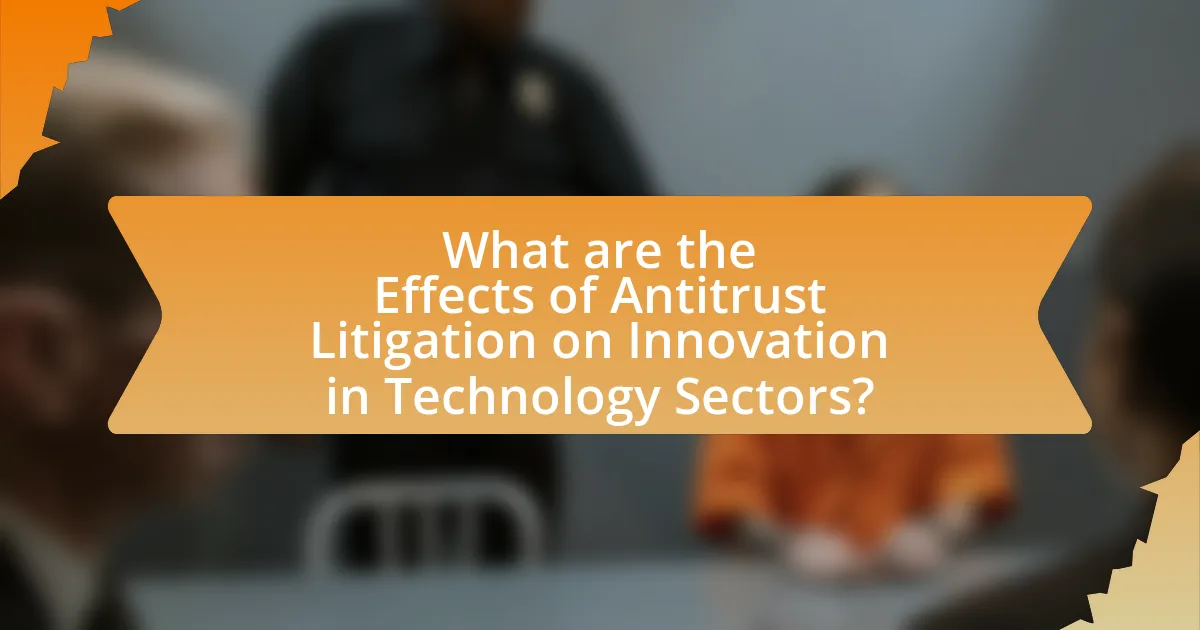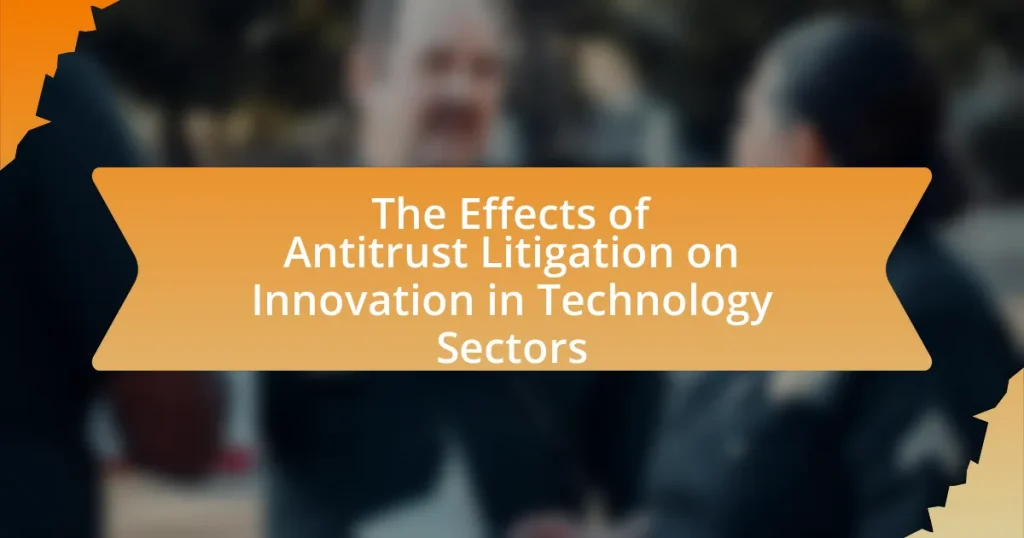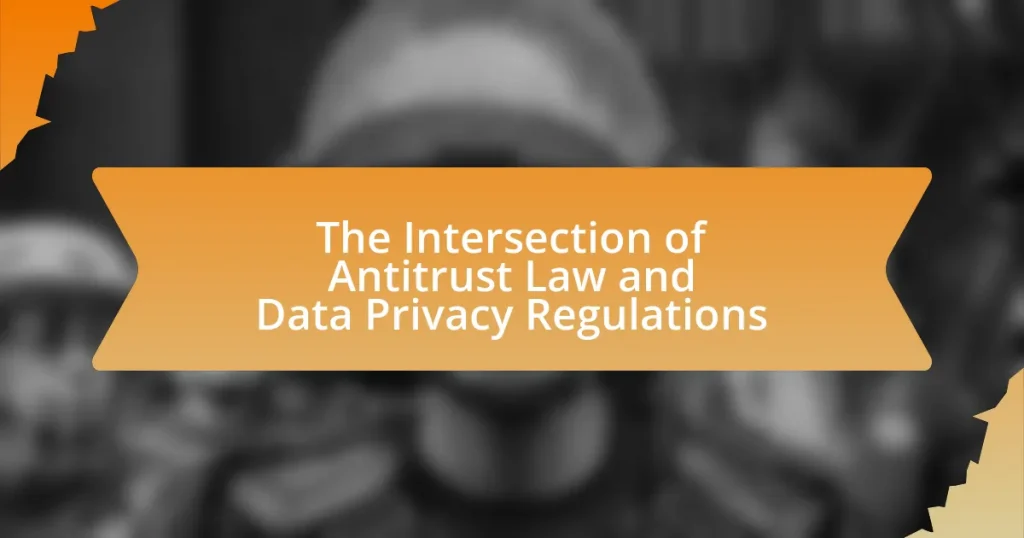Antitrust litigation significantly impacts innovation in technology sectors, presenting both positive and negative effects. It can stimulate innovation by fostering competition, as seen in historical cases like AT&T and Microsoft, which led to advancements in telecommunications and software. Conversely, excessive litigation can create uncertainty and divert resources from research and development, ultimately stifling innovation. The article explores the mechanisms through which antitrust actions influence technological advancements, the varying impacts of different types of cases, and the balance policymakers must strike to promote fair competition while encouraging innovation. Additionally, it highlights the lessons learned from past cases and best practices for technology companies navigating the complexities of antitrust regulations.

What are the Effects of Antitrust Litigation on Innovation in Technology Sectors?
Antitrust litigation can have both positive and negative effects on innovation in technology sectors. On one hand, it can stimulate innovation by promoting competition, which encourages companies to improve their products and services to gain market share. For instance, the breakup of monopolistic practices, as seen in the case of AT&T in the 1980s, led to increased innovation in telecommunications technologies. On the other hand, excessive or poorly timed antitrust litigation can stifle innovation by creating uncertainty and diverting resources away from research and development. A study by the National Bureau of Economic Research found that firms facing antitrust scrutiny often reduce their investment in innovation due to the fear of legal repercussions and the costs associated with litigation. Thus, while antitrust litigation can foster a competitive environment that drives innovation, it can also hinder it if not managed appropriately.
How does antitrust litigation influence technological advancements?
Antitrust litigation influences technological advancements by promoting competition, which drives innovation. When companies face legal challenges for anti-competitive practices, they are compelled to innovate to maintain or enhance their market position. For instance, the antitrust case against Microsoft in the late 1990s led to increased competition in the software market, resulting in rapid advancements in operating systems and applications. Additionally, the scrutiny from antitrust actions can deter monopolistic behaviors, ensuring that smaller firms have opportunities to innovate and contribute to technological progress. This dynamic fosters an environment where continuous improvement and new technologies emerge, ultimately benefiting consumers and the industry as a whole.
What are the mechanisms through which antitrust litigation affects innovation?
Antitrust litigation affects innovation primarily through deterrence, resource allocation, and market dynamics. Deterrence occurs as companies may alter their behavior to avoid legal repercussions, leading to reduced risk-taking and fewer innovative projects. Resource allocation is impacted as firms divert funds from research and development to legal defenses, which can stifle innovation. Additionally, market dynamics shift as antitrust actions can disrupt established monopolies or oligopolies, potentially fostering competition that encourages innovation. For instance, the 1998 antitrust case against Microsoft led to increased competition in the software market, resulting in a surge of innovative products and services.
How do different types of antitrust cases impact innovation differently?
Different types of antitrust cases impact innovation in technology sectors by either fostering competitive environments or stifling market dynamics. For instance, cases focused on monopolistic practices, such as those against Microsoft in the late 1990s, often lead to increased competition, encouraging innovation as companies strive to differentiate themselves. Conversely, cases that result in excessive regulation can create barriers to entry, discouraging startups and reducing overall innovation. Research by the National Bureau of Economic Research indicates that aggressive antitrust enforcement can lead to a 20% increase in innovation output in competitive markets, while overly stringent regulations can decrease innovation rates by up to 15%. Thus, the nature of antitrust cases significantly shapes the landscape of innovation within the technology sector.
Why is innovation crucial in technology sectors?
Innovation is crucial in technology sectors because it drives competitive advantage and economic growth. In rapidly evolving markets, companies that innovate can meet changing consumer demands, improve efficiency, and create new products or services. For instance, a report by McKinsey & Company highlights that organizations that prioritize innovation can achieve up to 30% higher revenue growth compared to their less innovative counterparts. This demonstrates that innovation not only enhances market position but also contributes significantly to overall economic development.
What role does competition play in fostering innovation?
Competition plays a crucial role in fostering innovation by driving companies to improve their products and services to gain market advantage. When firms compete, they are incentivized to invest in research and development, leading to technological advancements and creative solutions. For instance, a study by the National Bureau of Economic Research found that increased competition in the technology sector correlates with higher rates of innovation, as companies strive to differentiate themselves and capture consumer interest. This dynamic not only enhances product quality but also accelerates the pace of technological progress, benefiting consumers and the economy as a whole.
How do technological advancements contribute to economic growth?
Technological advancements contribute to economic growth by enhancing productivity, creating new markets, and fostering innovation. For instance, the introduction of automation and artificial intelligence has significantly increased efficiency in manufacturing and service sectors, leading to higher output with lower costs. According to a report by McKinsey Global Institute, automation could raise global productivity by 0.8 to 1.4 percent annually. Furthermore, technological advancements often lead to the development of new products and services, which can stimulate consumer demand and create jobs. The emergence of the internet and mobile technologies has generated entire industries, such as e-commerce and app development, contributing trillions to the global economy. Thus, the interplay between technological advancements and economic growth is evident through increased productivity, market expansion, and job creation.
What are the potential negative impacts of antitrust litigation on innovation?
Antitrust litigation can negatively impact innovation by creating uncertainty and discouraging investment in research and development. When companies face the threat of litigation, they may divert resources from innovative projects to legal defenses, which can stifle creativity and slow down technological advancements. For instance, a study by the National Bureau of Economic Research found that firms involved in antitrust cases often experience a decline in their innovation output, as measured by patent filings, during the litigation period. This suggests that the fear of legal repercussions can lead to a more risk-averse corporate culture, ultimately hindering the development of new technologies and solutions in the market.
How can antitrust actions stifle competition and innovation?
Antitrust actions can stifle competition and innovation by imposing restrictions that limit the operational flexibility of companies. When regulatory bodies intervene, they may prevent mergers or acquisitions that could enhance market efficiency and spur innovation, as seen in the case of the 2019 blocked merger between T-Mobile and Sprint, which was argued to potentially benefit consumers through improved services and lower prices. Additionally, antitrust litigation can create a climate of uncertainty, discouraging investment in research and development; for instance, companies may allocate resources to legal defenses rather than innovative projects, as evidenced by the increased legal costs faced by firms involved in prolonged antitrust disputes. This diversion of focus and resources ultimately hampers technological advancement and competitive dynamics in the market.
What are the long-term consequences of prolonged litigation on tech companies?
Prolonged litigation has significant long-term consequences for tech companies, primarily manifesting as financial strain, resource diversion, and stifled innovation. Financially, companies often incur substantial legal costs, which can divert funds from research and development; for instance, a study by the American Bar Association found that litigation can consume up to 20% of a company’s annual revenue. Additionally, the diversion of management attention to legal battles can hinder strategic decision-making and operational efficiency. This distraction can lead to missed opportunities in innovation, as companies may prioritize legal defenses over developing new technologies or improving existing products. Furthermore, prolonged litigation can create a climate of uncertainty, discouraging investment and collaboration, which are crucial for technological advancement.
How can antitrust litigation lead to positive outcomes for innovation?
Antitrust litigation can lead to positive outcomes for innovation by promoting competition and preventing monopolistic practices. When companies face legal challenges for anti-competitive behavior, they are compelled to innovate to maintain their market position and attract consumers. For instance, the antitrust case against Microsoft in the late 1990s resulted in the company enhancing its software offerings and fostering a more competitive environment for emerging tech firms. This legal scrutiny encourages firms to invest in research and development, ultimately leading to technological advancements and improved products for consumers.
What are the benefits of enforcing antitrust laws in technology sectors?
Enforcing antitrust laws in technology sectors promotes competition, which leads to innovation and better consumer choices. By preventing monopolistic practices, these laws ensure that multiple companies can compete, driving them to improve their products and services. For instance, the U.S. Department of Justice’s antitrust case against Microsoft in the late 1990s aimed to dismantle its monopoly on PC operating systems, resulting in increased competition from companies like Apple and Linux, which spurred advancements in software and user experience. Additionally, enforcing these laws can prevent price gouging and ensure fair access to technology, benefiting consumers and fostering a diverse marketplace.
How can antitrust litigation encourage fair competition and innovation?
Antitrust litigation encourages fair competition and innovation by dismantling monopolistic practices that stifle market entry and limit consumer choice. When companies engage in anti-competitive behavior, such as price-fixing or exclusive agreements, antitrust lawsuits can lead to penalties and structural changes that promote a more level playing field. For instance, the landmark case against Microsoft in the late 1990s resulted in significant changes to its business practices, allowing smaller software developers to compete more effectively, which spurred innovation in the technology sector. Additionally, antitrust actions can deter firms from engaging in anti-competitive conduct, fostering an environment where new entrants can thrive and contribute innovative solutions to the market.
What are the key challenges in balancing antitrust litigation and innovation?
The key challenges in balancing antitrust litigation and innovation include the risk of stifling competition and the potential for discouraging investment in research and development. Antitrust litigation can create uncertainty for companies, leading to reduced incentives to innovate due to fear of legal repercussions or penalties. For instance, a study by the National Bureau of Economic Research found that aggressive antitrust enforcement can lead to a decline in innovation output, particularly in high-tech industries where rapid advancements are crucial. Additionally, the complexity of determining anti-competitive behavior can result in lengthy legal battles that divert resources away from innovation efforts, further hindering technological progress.
How do policymakers navigate the tension between regulation and innovation?
Policymakers navigate the tension between regulation and innovation by implementing adaptive regulatory frameworks that promote competition while ensuring consumer protection. For instance, they may adopt a principle-based approach that allows for flexibility in regulations, enabling businesses to innovate without excessive constraints. Evidence of this can be seen in the European Union’s General Data Protection Regulation (GDPR), which aims to protect user data while encouraging technological advancements in data management. Additionally, policymakers often engage with stakeholders, including industry leaders and consumer advocacy groups, to balance interests and foster an environment conducive to innovation. This collaborative approach helps to mitigate the risks of stifling innovation through overly stringent regulations.
What strategies can be employed to minimize negative impacts on innovation?
To minimize negative impacts on innovation, companies can adopt strategies such as fostering a culture of collaboration, investing in research and development, and engaging in proactive regulatory compliance. Fostering collaboration encourages knowledge sharing and idea generation, which can lead to innovative solutions. Investing in research and development ensures that resources are allocated towards creating new technologies and improving existing ones, which is crucial in competitive technology sectors. Proactive regulatory compliance helps organizations navigate antitrust laws effectively, reducing the risk of litigation that can stifle innovation. For instance, a study by the National Bureau of Economic Research found that firms that prioritize compliance and innovation simultaneously tend to outperform their competitors in terms of technological advancements.
What lessons can be learned from past antitrust cases in technology sectors?
Past antitrust cases in technology sectors reveal critical lessons about market competition and innovation. One key lesson is that aggressive enforcement of antitrust laws can prevent monopolistic behaviors, as seen in the United States v. Microsoft Corp. case, where the court found Microsoft had engaged in anti-competitive practices that stifled innovation from rivals. This case demonstrated that regulatory actions can promote a healthier competitive environment, encouraging new entrants and fostering technological advancements. Additionally, the European Union’s actions against Google for anti-competitive practices in search and advertising highlight the importance of maintaining fair competition to ensure diverse innovation pathways. These cases collectively underscore the necessity of vigilant antitrust oversight to balance market power and stimulate innovation in the technology sector.
What are notable examples of antitrust litigation affecting innovation?
Notable examples of antitrust litigation affecting innovation include the United States v. Microsoft Corp. case in the late 1990s and the European Commission’s actions against Google in the 2010s. In the Microsoft case, the U.S. government argued that Microsoft’s practices stifled competition and innovation in the software market, leading to a settlement that required Microsoft to share its application programming interfaces with third-party developers, which ultimately fostered greater innovation in software development. Similarly, the European Commission fined Google for anti-competitive practices related to its search engine and advertising services, which aimed to ensure fair competition and encourage innovation among smaller search engines and advertisers. These cases illustrate how antitrust litigation can reshape market dynamics and promote innovation by dismantling monopolistic practices.
How have past cases shaped current antitrust policies in technology?
Past antitrust cases have significantly influenced current antitrust policies in technology by establishing legal precedents that guide regulatory actions. For instance, the landmark case against Microsoft in the late 1990s set a framework for evaluating monopolistic practices, leading to increased scrutiny of tech giants regarding market dominance and anti-competitive behavior. This case highlighted the importance of maintaining competitive markets to foster innovation, which has been echoed in subsequent policies aimed at preventing monopolistic practices by companies like Google and Facebook. The outcomes of these cases have prompted regulators to adopt more stringent measures, such as the proposed updates to antitrust laws in the U.S. and the European Union’s Digital Markets Act, aimed at ensuring fair competition in the technology sector.
What best practices can technology companies adopt in light of antitrust litigation?
Technology companies can adopt several best practices in light of antitrust litigation, including ensuring compliance with antitrust laws, fostering transparency in business practices, and promoting fair competition. Compliance with antitrust laws involves regularly reviewing business practices to avoid anti-competitive behavior, which can mitigate legal risks. Transparency can be enhanced by openly communicating business strategies and decisions to stakeholders, thereby building trust and reducing the likelihood of litigation. Promoting fair competition can be achieved by engaging in ethical business practices and collaborating with competitors in ways that do not violate antitrust regulations, which can foster innovation and improve market dynamics. These practices are supported by historical cases where companies that prioritized compliance and transparency faced fewer legal challenges and maintained a positive public image.



